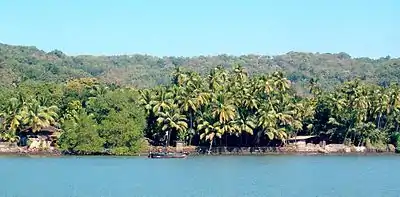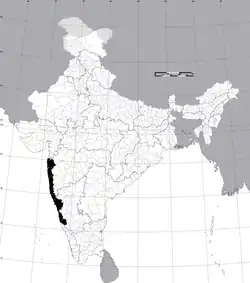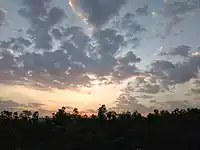Konkan
The Konkan (Konkani: कोंकण) is a stretch of land by the western coast of India, bound by the Daman Ganga at Damaon in the north, to Anjediva Island next to Karwar town in the south; with the Arabian Sea to the west and the Deccan plateau in the east.[1] The hinterland east of the coast has numerous river valleys and riverine islands among the hilly slopes (the Western Ghats or Ghauts) leading up into the tablelands of the Deccan. The region has been recognised by name, since at least the time of Strabo in the third century C.E..[1] It had a thriving mercantile port with Arab tradesmen from the 10th century.[2] The best-known islands of Konkan are Ilhas de Goa, the site of the Goa State's capital at Panjim, and the seven islands of Mumbai. Mumbai is the headquarters of the Konkan division, the capital of the State of Maharashtra, as well as India's financial centre.[3]
Konkan
कोंकण कोकण Kokan Concan | |
|---|---|
Region | |
 Dabhol in Ratnagiri district, Konkan division, Maharashtra State. Beaches dotted with swaying coconut palms are a ubiquitous sight along the Konkani coast. | |
 Modern Districts of India forming the Konkan | |
| Coordinates: 15.6°N 73.8°E | |
| Country | |
Definition
Historically, the limits of Konkan have been flexible, and it has been known by additional names like "Aparanta" and "Gomanchal", the latter being defined as the coastal area between the Daman River in the north, and the Gangavalli River in the south.[4]
The ancient Sapta Konkan was a larger geographical area that extended from Gujarat to Kerala and included the whole region of coastal Maharashtra and coastal Karnataka.[1] However, this segment overlaps the Konkan and Malabar coast continuum; and usually corresponds to the southernmost and northernmost stretches of these locales respectively.
Etymology
According to the Sahyadrikhanda of the Skanda Purana, Parashurama threw his axe into the sea and commanded the Sea God to recede up to the point where his axe landed. The new piece of land thus recovered came to be known as Saptah-Konkana, meaning "piece of earth", "corner of earth", or "piece of corner", derived from Sanskrit words: koṇa (कोण, corner) + kaṇa (कण, piece).[5][6] Xuanzang, the noted Chinese Buddhist monk, mentioned this region in his book as Konkana Desha; Varahamihira's Brihat-Samhita described the Konkan as a region of India; and author Ratnakosh of the 15th century mentioned the phrase Konkandesha.[1]
Geography


The Konkan extends throughout the western coasts of Maharashtra, Goa and Karnataka.[1] It is bounded by the Western Mountains' range (also known as Sahyadri) in the east, the Arabian Sea in the west, the Daman Ganga in the north, and the River Aghanashini in the south. The Gangavalli flows in the district of Uttara Kannada in present-day Karnataka. Its northern bank constitutes the southernmost portion of Konkan. The towns of Karwar, Ankola, Kumta, Honavar and Bhatkal fall within the Konkan coast. The largest city on the Konkan coast is Mumbai. Districts on the Konkan coast are, from north to south:[7]
Ethnology
The main ethnolinguistic group of the Konkan region is the Konkani people. Specific caste and communities found in the region are the Aagri, Koli, Bhandari, Kunbi, Maratha, Gabit, Mangela, Karadi, Phudagi, Vaiti, Kharvi, Teli, Kumbhar, Nhavi, Dhobi, Kasar, Sutar, Lohar, Chambhar, Mahar, Dhangar, Gaud Saraswat Brahmin (also includes Rajapur Saraswats and Chitrapur Saraswats), Daivajna Brahmin, Kudaldeshkar, Pathare Prabhu, Gomantak Maratha, Chitpawan, Karhade, Kayastha Prabhu, Panchkalshi, Vani, Komarpant, Vadval, Gavli, Ghorpi, Nath Jogi, Gurav, Pagi, Kalan, Ghadi, Padti, Vanjari, Namdev Shimpi and others. Billava, Bunt, Nadavara, Mogaveera and Linghayat communities found in the parts of Karnataka which are near to Konkan.
Tribal communities include the Katkari, Thakar, Konkana, Warli and Mahadev Koli, mainly found in the northern and central parts of Konkan. The Dubla and Dhodia tribes live in southern Gujarat, Dadra and Nagar Haveli and Palghar district of Maharashtra. Palghar district has the largest percentage of tribal population in Konkan. A small nomadic tribe called the Vanarmare is found in southern parts of Konkan, which was originally associated with the hunting of monkeys. The Gauda and Velip tribes are found in Goa.
The Jewish community called Bene Israel is mainly found in Raigad district. The Christians included Bombay East Indians in North Konkan and Mumbai, Goan Catholics in Goa, Karwari Catholics in Uttara Kannada as well as Mangalorean Catholics in Udupi and Dakshina Kannada.
Major Muslim communities like Konkani Muslims and Nawayaths are scattered throughout the whole region. They are reportedly descendants of people who came from Hadhramaut (in Yemen or South Arabia),[8] and other parts of Arabia and the Middle East. The Siddis have their roots in Africa.[2]
See also
References
- Saradesāya, Manohararāya (2000). "The Land, the People and the Language". A History of Konkani Literature: From 1500 to 1992. India: Sahitya Akademi. pp. 1–14. ISBN 978-8-1720-1664-7.
- Wink, André (1991). Al-hind: The Making of the Indo-islamic World. Brill. p. 68. ISBN 978-90-04-09249-5.
- "Provisional Population Totals, Census of India 2011; Cities having population 1 lakh and above" (PDF). Office of the Registrar General & Census Commissioner, India. Archived from the original (PDF) on 7 May 2012. Retrieved 26 March 2012.
- De Souza, Teotonio R., ed. (1990). Goa Through the Ages: An economic history - Volume 2. India: Concept Publishing Company. pp. 8–9. ISBN 9788170222590.
- Shastri Gaytonde, Gajanan (ed.). Shree Scanda Puran (Sayadri Khandha) (in Marathi). Mumbai: Shree Katyani Publication.
- Satoskar, B. D. Gomantak Prakruti ani Sanskruti. Part 1 (in Marathi). Shubhada Publication. p. 206.
- Limited, Nigade Software Technologies (opc) Private. "Konkan Division District List (कोंकण विभाग जिल्हा यादी)". www.swapp.co.in. Retrieved 26 January 2022.
- Khalidi, Omar (1996), "The Arabs of Hadramawt in Hyderabad", in Kulkarni; Naeem; De Souza (eds.), Mediaeval Deccan History, Bombay: Popular Prakashan, ISBN 978-8-1715-4579-7
External links
 Konkan travel guide from Wikivoyage
Konkan travel guide from Wikivoyage- Konkan Tourism – a complete guide on tourism
- Konkan Hotels
- Tourist Place to visit Konkan Darshan